
Undeniably, the Sun is the nearest star to our planet. In terms of cosmic measurements, the distance between Earth and the Sun is relatively short: it takes sunlight only 8 minutes to reach our planet.
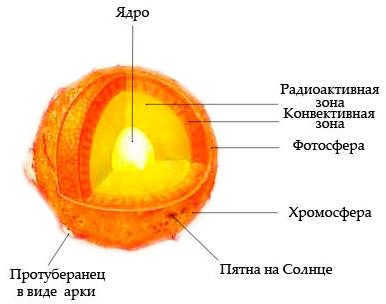
The Sun’s convective zone
The radioactive zone of the Sun, which has a radius of approximately 140 thousand kilometers, occupies around 2/3 of its inner diameter. As photons move away from the center, they gradually lose energy through collisions, a phenomenon known as convection. This process can be likened to the boiling of water in a kettle, where the heating element provides more energy than the heat conducted away. As a result, the hot water rises while the cooler water sinks, creating a continuous circulation known as convection. In the convective zone of the Sun, denser gas is distributed over the surface, cools down, and returns to the center. This constant mixing is responsible for the granular structure, known as granulations, observed on the Sun’s surface when viewed through a telescope. The presence of convection beneath the photosphere is what gives the Sun its grain-like appearance.
Located just behind the convective zone, the Sun’s photosphere is a thin layer (400 km) that serves as the “true solar surface” visible from Earth. In 1885, the Frenchman Janssen captured the first photographs of granules on the photosphere. On average, these granules measure 1000 km in size, move at a speed of 1 km/sec, and have a lifespan of approximately 15 minutes. Within the equatorial region of the photosphere, dark formations can be observed before they gradually shift. These formations are characterized by the presence of strong magnetic fields and acquire their dark color due to their lower temperature compared to the surrounding photosphere.
The Chromosphere of the Sun
The chromosphere of the Sun, also known as the colored sphere, is a thick layer that spans approximately 10,000 km in the solar atmosphere. This region is positioned just behind the photosphere. Observing the chromosphere can be challenging due to its close proximity to the photosphere. However, it becomes more visible during solar eclipses when the Moon obstructs the photosphere’s light.
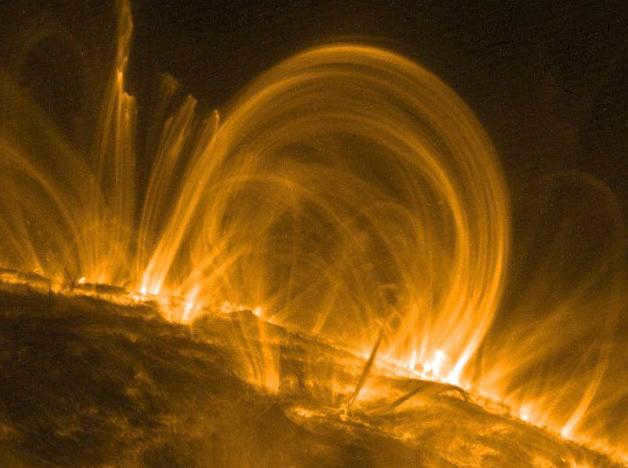
Solar prominences are immense discharges of hydrogen that bear resemblance to luminous elongated filaments. These prominences ascend to vast distances, stretching out to the Sun’s diameter of 1.4 million kilometers, traveling at velocities of approximately 300 kilometers per second, and attaining temperatures as lofty as 10,000 degrees Celsius.
Solar corona
The solar corona is the outermost layer of the Sun’s atmosphere, which extends beyond the chromosphere. With a length that can reach several solar diameters, the exact boundary of the solar corona remains a mystery to scientists.

The solar corona is composed of a rarefied and highly ionized plasma. It is made up of heavy ions, helium nuclei with electrons, and protons. The temperature of the corona can range from 1 to 2 million Kelvin, compared to the Sun’s surface.
The solar wind is a continuous flow of plasma that emanates from the outer layer of the solar atmosphere. It consists of protons, atomic nuclei, and electrons. The velocity of the solar wind can vary between 300 km/sec and 1500 km/sec, depending on the processes occurring on the Sun. The solar wind extends throughout the solar system and, when interacting with Earth’s magnetic field, produces various phenomena, including the aurora borealis.
Distinctive Characteristics of the Sun
– Mass of the Sun: 2∙1030 kilograms (332,946 times the mass of the Earth).
– Sun’s Diameter: 1,392,000 kilometers
– Sun’s Radius: 696,000 km
– Average density of the Sun: 1,400 kg/m3
– Axis tilt of the Sun: 7.25° (in relation to the ecliptic plane)
– Surface temperature of the Sun: 5,780 K
– Temperature at the core of the Sun: 15 million degrees
– Spectral class of the Sun: G2 V
– Average distance between the Sun and Earth: 150 million kilometers.
– Age of the Sun: 5 billion years
– Rotation period of the Sun: 25,380 days
– Luminosity of the Sun: 3.86∙1026 W
– Visible stellar magnitude of the Sun: 26.75m
Navigation
Blog
One of the biggest obstacles in any future mission to Mars is the successful and secure transportation of astronauts to the Red Planet’s surface.
Even today, the existence of extraterrestrial life or advanced alien civilizations continues to captivate the minds of scientists, philosophers, and the general public. Numerous films and literature explore this intriguing topic.

When the sun ascends, the initial thing we observe is a star that reigns over our solar system. Not only does the sun illuminate our planet, but it also gives rise to meteorological phenomena and sustains life on Earth. Numerous individuals have pondered about the temperature of the sun. The truth is, the sun is recognized as a colossal fountain of nuclear energy situated at the core of the solar system.
In this article, we will unveil the mystery of the sun’s temperature, its characteristics, and its significance.
Main features

The center of the solar system holds an enormous source of nuclear energy that has yet to be fully measured. This celestial body is known as the sun and is classified as a star. Its temperature is so extreme that one could approach it directly without any protective gear. Even from a long distance away, the sun’s rays have the ability to scorch our skin and cause severe burns. Despite the presence of various filters in our atmosphere that help to diminish ultraviolet radiation, the sun can still cause harm to us at this distance.
Not only does the sun keep us warm and allow for the existence of meteorological phenomena and David on this planet, but it also serves as a vital source of vitamins. Receiving sunlight in moderate amounts provides humans and other living beings with a great deal of vitality. The temperature of the sun is influenced by various factors. The perceived temperature of our sun is largely determined by factors such as the season of the year, global warming, and the amount of greenhouse gases present in the atmosphere.
What is the temperature of the sun?
What is the sun’s temperature?
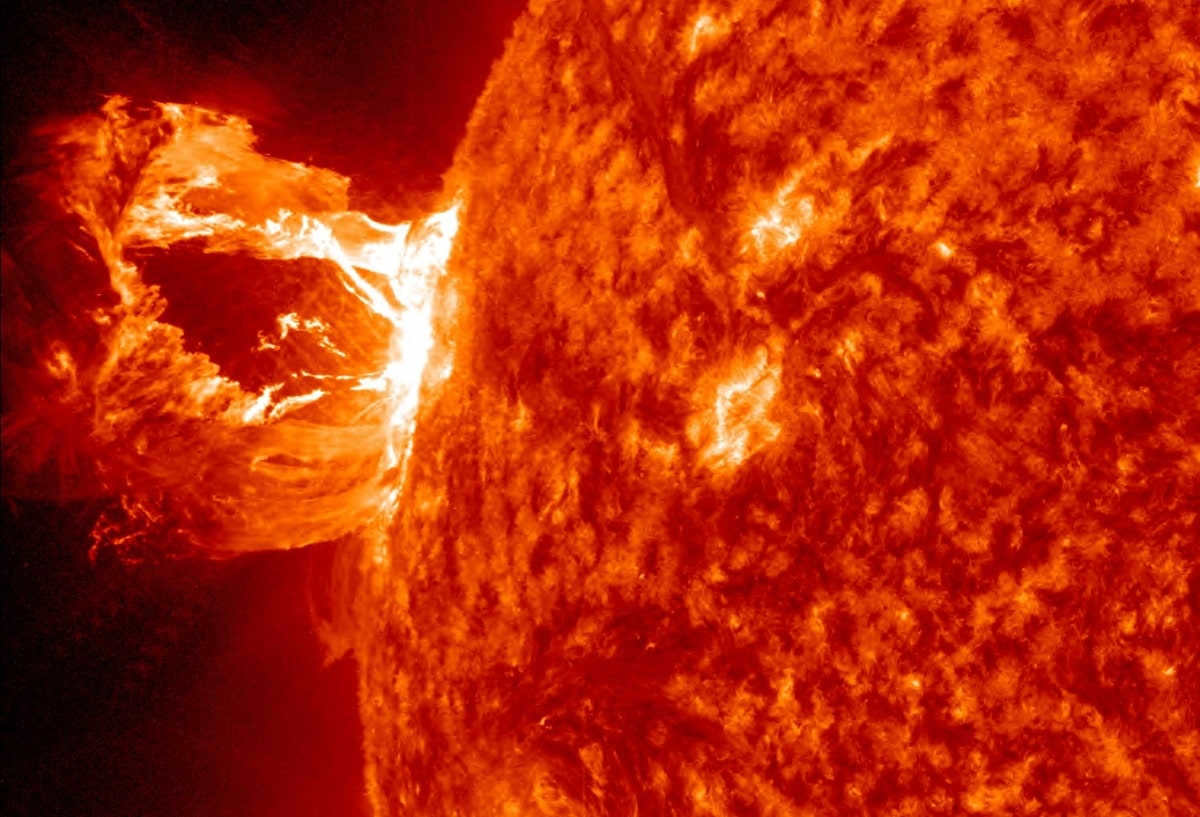
Human activities and the release of pollutant gases have significantly impacted our atmosphere, altering its original function. Given its immense size, the Sun has always been a source of fascination and debate. In the XNUMXth century, scientists successfully determined the temperature of the sun, which reflects its surface temperature. It is logical to assume that the temperature inside the sun is even higher.
To determine the temperature of the sun, scientists can analyze its brightness and the distribution of wavelengths in the visible spectrum. Based on these measurements, the estimated temperature is approximately 6,000 degrees Celsius. This outer layer of the sun, known as the photosphere, is the most visible part of the star. The yellow hue of the sun is a result of its high temperature. It is hypothesized that if the temperature increases, the sun will appear more blue in color. Conversely, if the temperature decreases, it will take on a redder hue.
In order for nuclear fusion to take place, there must be available hydrogen molecules, along with both high pressure and high temperature. When these three variables align, nuclear fusion occurs. These reactions result in the release of energy across the surface of the sun. This energy emission includes both heat and light. It is estimated that approximately 700 million tons of hydrogen are converted into helium every second. As a result, this process generates around 5 million tons of net energy.
One method of determining the Sun’s temperature involves measuring the radiation that reaches the Earth and then using the distance and size of the Sun to calculate it.
The significance of the photosphere in determining the Sun’s temperature
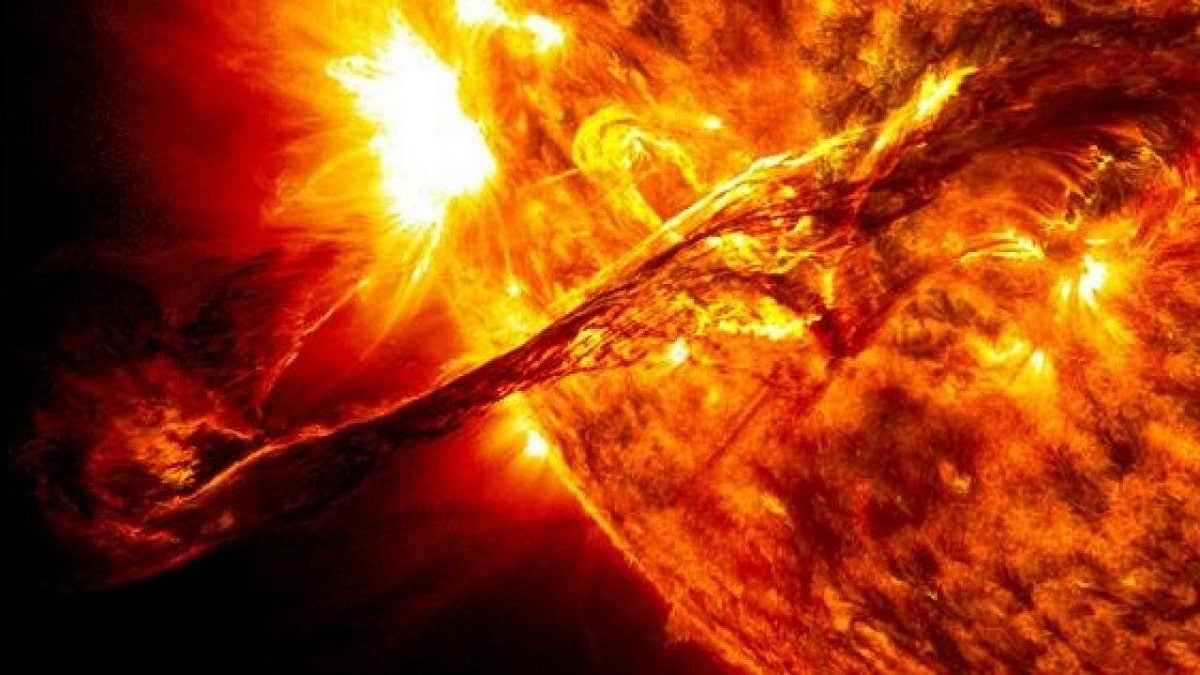
The photosphere is the region responsible for measuring the visible light we receive from the sun. It is the most dense region and has its own atmosphere. Despite appearing dimly, it is the coolest area of the sun. When observed, it appears as a disk of dark spots created by intense energy emissions. These spots are the result of the solar magnetic field, which regulates all solar activity.
Similar to our planet, the Sun also has convection currents, resulting in a motion pattern known as solar granulation. This phenomenon is responsible for the distribution of heat throughout the Sun.
Internally, the Sun reaches temperatures of 15 million degrees Celsius, while its external temperature is about 5,500 degrees Celsius.
By providing this information, I hope to enhance your understanding of the Sun’s temperature.
This article’s content adheres to our editorial ethics principles. If you notice any errors, please click here to report them.
Full Article Summary: Network Meteorology " astronomy " Examining the Sun’s Temperature
Researchers have conclusively solved a cosmic enigma regarding the temperature of the cosmos
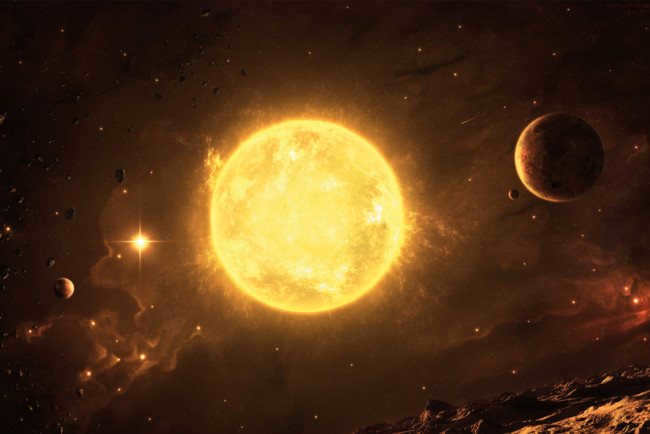
Why is it so frigid in outer space despite the Sun’s scorching heat? One might assume this is a basic question covered in school, but upon further reflection, it becomes evident that the answer is not as straightforward. Scientists have provided a comprehensive explanation for this cosmic enigma.
Additionally, learn how to safeguard your eyes from the sun in the following article:
The Sun, which is a yellow dwarf of the G2V type, is the nearest star to us. Despite being smaller compared to other astronomical objects, it is incredibly hot, with a surface temperature of 5,500 degrees Celsius and a core temperature of 15.7 million Kelvin. However, if you travel far away from the Sun, such as to the orbit of Neptune, the temperature drastically decreases to -270°C. This temperature is only three degrees above absolute zero. The question arises, how is this possible?
What exactly is weightlessness? Previously, we held the belief that astronauts in space experience a floating sensation, seemingly defying the principles of gravity. Consequently, numerous individuals hold the misconception that gravity does not exist in outer space. In reality, gravity permeates every corner of the universe and stands as the paramount force influencing all entities inhabiting the vast expanse of space.

What happens to an astronaut in a weightless environment? Well, to be more precise, it can be described as experiencing free fall.
So why don’t astronauts plummet towards Earth? It’s due to the principle of free-fall acceleration. If an astronaut were to drop an apple on a space station, both the apple and the astronaut would fall: not towards Earth, but rather around it.
This is because they are accelerating in relation to the Earth. Objects in Earth’s orbit seem to be floating, even though they are actually moving at the same speed as a spacecraft in orbit, which is over 28,000 kilometers per hour.
A shield against scorching heat and extreme cold
Elizabeth Abel, a thermal engineer working on NASA’s DART project, is currently focused on developing cutting-edge thermal management systems for spacecraft designed for long-duration space missions. One of her notable endeavors was the Parker Solar Probe, which is responsible for gathering valuable data from the outermost layer of a star’s atmosphere known as the corona. In April 2020, the probe achieved a remarkable feat by coming as close as possible to the sun’s surface, braving a distance of 15 million kilometers. This daring maneuver was made possible by the strategic placement of a highly efficient heat shield on one side of the probe.
The Parker probe is equipped with a unique temperature distribution, with one side meticulously heated up to a scorching 250 degrees Celsius, while the other side is chillingly cooled down to a bone-chilling -238 degrees Celsius.
"The heat shield was engineered with the intention of preventing the spacecraft from being melted by solar radiation. As the shield heats up to 250°C, the actual vehicle maintains a chilly hull temperature of -238°C," Elisabeth Abel clarifies.
The significant contrast in temperature between the frigidness of space and the scorching heat of the Sun presents significant challenges. Specific components of the spacecraft require a moderate temperature to prevent overheating and potential short circuits, whereas others necessitate heating elements to ensure proper functionality,"
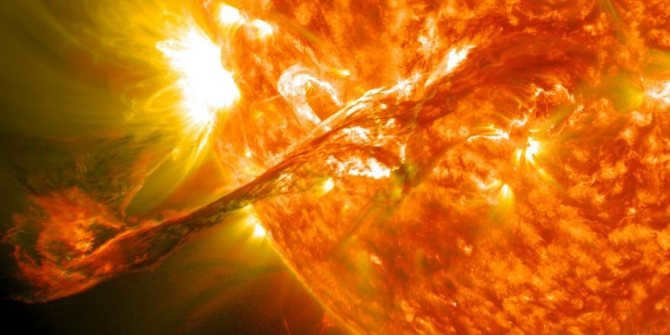
All celestial bodies in the solar system receive heat and light from a single origin – the Sun. It is the colossal glowing sphere that has facilitated the emergence and advancement of life on Earth. However, despite the Sun’s scorching temperature, why is outer space so cold?
Let’s make a comparison of temperature measurements. What do the numerical values of the Sun’s heat signify? Well, if one were to find themselves in the core, the temperature would skyrocket to a staggering 14 million K! The surface may appear cooler, but it still reaches a remarkable 6000 K.
On the other hand, outer space plummets to 0 K or -273.15°C in terms of warmth (excluding relic radiation). Why does this occur? Why does space not experience any increase in temperature?
Heat propagates through space by means of radiation. This involves an infrared energy wave that travels from hotter objects to cooler ones. These radiation waves rouse the molecules they come into contact with, causing them to warm up.

Temperature near the sun is 0 K or -273.15°C in outer space
This is the process by which heat is transferred from a star to Earth. However, there is a distinction: the radiation only heats the molecules and substances in its path, leaving everything else cold.
On Earth, heat is spread in three ways: conduction, convection, and radiation. Even in the shade and at night, the air remains warm because heat is transferred from starlight to molecules in Earth’s atmosphere, which then pass on the extra energy to other molecules. This creates a chain reaction that warms up areas outside of direct sunlight.
However, the vast expanse of outer space is mostly devoid of matter. The minuscule gas molecules are widely dispersed and rarely interact, making heat transfer through conduction virtually impossible. Likewise, convection, which relies on the force of gravity, is rendered ineffective in the weightless environment of space.

The Parker space probe embarked on a mission to investigate the solar atmosphere
This issue must be considered by spacecraft engineers who design vessels for long space voyages or close encounters with the Sun. A fascinating example is the Parker probe, which was dispatched to examine the solar atmosphere.
I mean, this spacecraft is gradually approaching the very inferno of the solar system, yet it remains intact! It all comes down to the protective heat shield that prevents the sun’s rays from reaching the probe’s surface. Thus, it must withstand extreme heat on one side while being exposed to the frigid vacuum of space on the other.
We need to devise various systems that enable the spacecraft to maintain a cool enough temperature to avoid short circuits, while also preventing overheating and melting due to solar radiation.
Due to the extreme temperature, the gas particles within the Sun – consisting of atomic nuclei and free electrons – are moving at incredibly high speeds. Each atomic nucleus is composed of protons and neutrons. Protons carry a positive electric charge, while neutrons are neutral. The different elements are distinguished by the varying number of protons and neutrons, acting as the building blocks. A hydrogen atom’s nucleus contains a single proton, while a helium atom’s nucleus consists of two protons and two neutrons.
When four hydrogen nuclei combine, they form a helium nucleus, along with photons and other small particles. These photons are responsible for the light that travels in every direction.
According to scientists, approximately four million tons of matter undergoes conversion into radiant energy within the solar core every second. This energy is then dispersed into space and eventually reaches the Earth.
It is important to mention that the temperature near the solar core is estimated to be around 14 million degrees, while the radiation power reaching our planet amounts to approximately 1000 watts per square meter of surface.
References and notes:
- Four hydrogen atoms (mass = 1.008) undergo fusion to form helium (mass 4.0039), resulting in a loss of 0.0281 atomic mass units (1 AMU = 1.66 x 10 -27 kg), and releasing 4.2 x 10 -12 joules of energy.
- Man-made hydrogen bombs utilize deuterium and tritium, isotopes of hydrogen, along with some lithium. The sun primarily utilizes ordinary hydrogen, which undergoes fusion to form heavier elements, ensuring a steady burn. Deuterium, being an intermediate step, regulates the rate of the fusion reaction process in the sun. In hydrogen bombs, this step is skipped and the process begins with deuterium.
- The complete fusion reaction can be represented as follows: 4 1 H -> 4 He + 2e + + + 2νe, where e+ represents the positron or antielectron, and νe represents the electron neutrino.
- Previously, fusion theory faced a significant challenge due to the absence of evidence for neutrino oscillation, a problem that persisted for billions of years. The prevailing belief among theoretical physicists was that neutrinos possessed absolutely no rest mass, rendering oscillation implausible. Nonetheless, in 2001, the existence of oscillation was confirmed, disproving the theorists’ initial assumptions. For more details, refer to the article by Newton, R., “Missing neutrinos discovered! No longer an ‘age’ meter,” published in the Journal TJ16
(3):123–125, 2002. - Evolutionists propose that the core of the sun is composed of helium, indicating an estimated age of 4.5 billion years. However, this assertion lacks concrete evidence from direct observations. Moreover, historical records indicate that the sun has never been dimmer, regardless of the presence of a substantial amount of helium in its core. In fact, if the sun did have a significant helium content, it would be an intentional design feature to maintain its high temperature. It is also possible that the abundance of helium contributes to the sun’s remarkable stability compared to other stars in the same spectral class. For more information on this topic, refer to Sarfati, D., in the journal of Creation22
(1):27-30, 1999. It is important to note that proponents of an ancient age for the sun do not directly measure its age. Instead, they rely on radiometric dating of meteorites, a method that has its own limitations, as we regularly demonstrate – see .
The sun is the “heart” of the solar system, with the planets and satellites orbiting around it. Scientists claim that even a slight change in the mass or size of the sun could render life on our planet non-existent. We have compiled a collection of fascinating facts about the sole star in our solar system for our readers.
1. The Sun is incredibly enormous
To put it into perspective, the Sun accounts for over 99.8% of the total mass of the Solar System. All the planets, satellites, and other small celestial bodies combined make up less than 0.2% of the solar system’s mass. More precisely, the Sun’s mass is approximately two nonillion kilograms (that’s two followed by thirty zeros). In terms of volume, the Sun is equivalent to about 1.3 million Earth-sized planets.
2. On a cosmic scale, the Sun does not possess considerable size
Although previously mentioned, the Sun is indeed of immense magnitude, but only when compared to other entities within the solar system. However, there exist significantly more massive entities within the universe. The Sun is categorized as a G-type star, commonly known as a yellow dwarf.
As its name implies, there exist much larger stars classified as giants, supergiants, and hypergiants. The red supergiant Uy Shield is positioned 9,500 light-years away from Earth. It currently holds the title of the largest known star, with a diameter approximately 1,700 times greater than that of the Sun. Its circumference measures 7.5 billion kilometers. It takes nearly seven hours for light to complete a full orbit around this star. If Uy Shield were to be located within the solar system, the star’s surface would extend beyond the orbit of Jupiter.
3. The eventual fate of the Sun
Stars have the ability to endure for an extensive period, possibly reaching billions of years, but eventually they meet their demise. The outcome of stars is determined by their magnitude. Smaller stars leave behind remnants known as brown dwarfs. Larger stars meet a more violent end – they transform into supernovae or even hypernovae and collapse into either a neutron star or a black hole. In exceptional cases, these colossal entities may even detonate, resulting in a gamma-ray burst.
The Sun lies somewhere in between – it won’t explode, but it won’t “deflate” either. Once the Sun depletes its hydrogen fuel, it will commence collapsing under its own mass, causing the core to grow denser and hotter. As a result, the Sun will expand and evolve into a red giant. Ultimately, it will contract and become a white dwarf, a minute stellar remnant with an incredible density (comparable in size to Earth but with the mass of the Sun).
4 The Composition of the Sun
The Sun is primarily composed of hydrogen and helium, similar to most other stars. Specifically, it is composed of approximately 71% hydrogen, 27% helium, and the remaining 2% consists of trace amounts of numerous chemical elements, predominantly oxygen and carbon.
5. The Sun’s Temperature
The temperature of the Sun varies depending on the specific region being discussed. The core of the Sun is incredibly hot, with temperatures reaching 15 million degrees Celsius. In contrast, the chromosphere is relatively cooler with temperatures in the range of a few thousand degrees. However, the temperature rapidly increases to millions of degrees in the Sun’s outer layer, known as the corona. The exact reason for this significant temperature difference is still unknown to scientists.
Theory about the movement of space debris The Sun has an estimated age of approximately 4.6 billion years. Scientists have determined this age by studying the age of other objects within the solar system that can be dated with more precision, such as meteorites and terrestrial rocks. This calculation is based on the assumption that the solar system formed as a cohesive unit. G-type stars like the Sun have a lifespan of about 9 to 10 billion years.
7. What is the brightness of the Sun
Sirius A is a massive star, while its companion star Sirius B is considerably smaller in size. Clearly, the Sun appears as the brightest star in the sky during daylight hours due to its relatively close proximity to Earth compared to other stars. However, during the nighttime, the brightest star in the sky is Sirius, followed by Canopus. The term “apparent stellar magnitude” is used to describe the brightness of a celestial object as observed from Earth. The Sun has an apparent magnitude of -27.8.
The rotation of the Sun is a complex process that varies across different regions. In simple terms, it takes approximately 25.4 days for the Sun to complete a full revolution. Unlike the Earth, the Sun does not rotate as a solid body. Its rotation is fastest at the equator, with a period of 24.5 days, and slowest near the poles, with a period of 38 days.
9. What are solar dark spots?
Occasionally, there are solar dark spots, also known as sunspots, on the surface of the Sun. These spots have a lower temperature (approximately 1226 degrees Celsius lower) compared to the rest of the solar surface and are caused by fluctuations in the Sun’s magnetic field. Some of these spots are large enough to be visible to the naked eye. Occasionally, groups of more than 100 sunspots can appear simultaneously, although this is extremely uncommon.
10. The Sun undergoes magnetic field changes
Approximately every 11 years, the magnetic poles of the Sun, both South and North, switch places. This phenomenon also occurs on Earth but with much less frequency. The last time this reversal occurred on Earth was around 800,000 years ago.
What is the reason behind the sun’s intense heat? The Sun, a luminous sphere composed of gas, possesses an incredibly high temperature at its core, which enables nuclear reactions to take place. The core of the Sun has a temperature that surpasses 15 million degrees Celsius, along with a pressure that is 200 billion times greater than that experienced on the Earth’s surface. This immense pressure leads to a gas density of approximately 1.5?105 kg/m3, which is even denser than iron. The surface of the Sun, on the other hand, maintains a temperature of 6,000 degrees Celsius. At this extreme heat, any substance found on Earth would melt. The core temperature of the Sun is thousands of times higher, exceeding 16,000,000°C! The Sun is greatly appreciated by the inhabitants of the Earth for its continuous provision of heat, resulting in the wonderful season of summer. However, it is important to exercise caution when exposed to the Sun’s rays, as they can cause sunburn on hot days.
Slide 5
from the presentation
“The Sun.”
The presentation file size is 11431 KB.

It is difficult to determine the precise altitude at which outer space commences. The International Aviation Federation has designated the boundary of space as 100 kilometers above sea level, known as the Karman line.
The aircraft must attain a velocity that corresponds to the threshold of space in order to achieve lift. The U.S. Air Force has identified an altitude of 50 miles (approximately 80 kilometers) as the starting point of space.
Both of these altitudes have been suggested as the demarcation of the upper atmosphere. However, there is no universally accepted definition of where space officially begins.
The Karman line for Venus is situated at an altitude of around 250 kilometers, while for Mars it is approximately 80 kilometers. In the case of celestial bodies with minimal or no atmosphere, such as Mercury, Earth’s Moon, or an asteroid, space commences directly at the surface of the object.
When a spaceship returns to Earth’s atmosphere, the altitude of the atmosphere is taken into account in order to calculate the trajectory and minimize its impact during re-entry. Usually, the re-entry altitude is set equal to or higher than the Pockets line. NASA uses a value of 400,000 feet (approximately 122 km).
Space Weather
To put it simply, “absolute zero” represents the lowest achievable temperature in the universe, beyond which it is impossible to get any colder. In the Celsius scale, this value is equivalent to -273.15 degrees. At this extreme temperature, atoms, the fundamental building blocks of all chemical elements, come to a complete halt in their movement. In the vast expanse of outer space, there are molecules present, albeit in very scarce quantities, leading to minimal interactions between them. The absence of any motion serves as a definitive indication of the presence of “absolute zero,” and you can learn more about this fascinating concept in the following article.
Fascinating Tidbit: The lowest recorded air temperature on Earth occurred in 1983 within the confines of Antarctica, plummeting to an astonishing -89.15 degrees Celsius.
When discussing the temperature in the Earth’s orbit, it is important to consider the presence of an atmosphere that consists of multiple distinct layers:
- The first layer is known as the troposphere, which extends up to approximately 10 km above the Earth’s surface. In this layer, the temperature gradually decreases by about 0.65º for every 100 meters of altitude.
- The next layer is the intermediate layer, where the temperature remains relatively constant without any further decrease.
- The stratosphere is located at a distance of 11-50 km from the Earth’s surface. Within the range of 11-25 km, the air cools down to -56.5ºC. Beyond 25 km, however, the temperature starts to rise and eventually reaches around 0ºC. Between 40 and 55 km, the temperature remains stable, creating a sort of intermediate layer.
- The temperature starts to decrease in the mesosphere, which is located 50 to 80-90 km from the Earth, at a rate of 0.25-0.5º per 100 meters.
- Around the 100 km mark from the Earth is the Karman Line, which is commonly considered the boundary between the atmosphere and space. At this point, the temperature is approximately -90ºC.
- The thermosphere extends up to 800 km above the Earth. From a height of 200-300 km, the temperature in outer space increases and reaches 1230ºC.
- After the thermosphere, there is the exosphere, which is characterized by a significant decrease in gas density – often referred to as the scattering sphere.
What is the temperature in the void of outer space?
And what is the temperature in the vast expanse of space (in Celsius) beyond Earth’s atmosphere? Where the cosmic vacuum exists?
In order to comprehend the nature of temperature fluctuations in different regions of space, it is imperative to delve into the question of composition. All matter is comprised of elementary particles (such as electrons, protons, photons, and others) that combine in specific arrangements to form atoms and molecules. These microparticles are in perpetual motion. In simple terms, heat is the energy released during this motion. The more vigorous the movement of microparticles, the higher the temperature of the body composed of them.
And the cosmic void is, naturally, devoid of matter, but nonetheless, there are particles in motion there (such as light-carrying photons). Naturally, the density of microparticles in the void is infinitely lower than on Earth, but motion still exists. Alongside the emission of heat-carrying photons by celestial bodies, there is also relic radiation present in space (which formed during the early stages of the Universe’s existence). The temperature in the expanse of space is influenced by planets and their moons, meteorites and comets, asteroids and nebulae, space debris and dust. All of these factors contribute to the overall environmental conditions.
Due to this, the temperature in outer space is not actually absolute zero, which is an extremely low temperature of -273º Celsius or 0º Kelvin. On average, it is slightly higher, around 2.7º Celsius. So, when asked how many degrees it is in space, the answer would be: Celsius – minus 270.425º, Kelvin – plus 2.725º, Fahrenheit – minus 454.8º.
Due to the lack of uniformity in the Universe, there is variation in the temperature readings across different points. In the majority of the space, the Celsius temperature hovers around minus 270.45º, but in regions with higher concentrations of dust and gas, it can be 10-20 degrees higher. However, the temperature near stars and planets is significantly higher.
Upper and lower limits
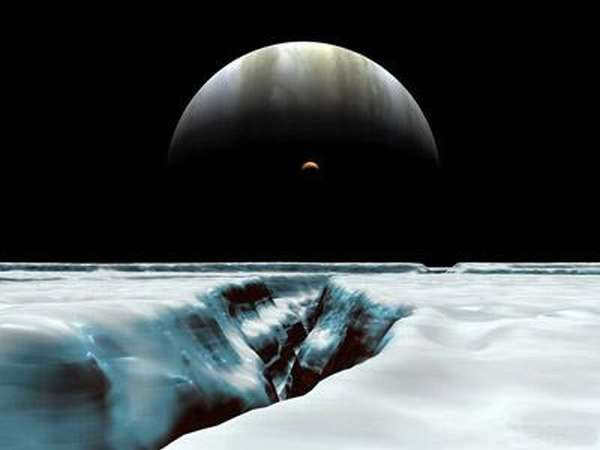
The base temperature in the vast expanse of outer space, which is determined by the background radiation originating from the colossal explosion known as the Big Bang, registers at a frigid 2.73 kelvin (K), equivalent to a bone-chilling -270.45 °C.
This represents the absolute coldest temperature achievable in the vacuum of space. The vacuum itself lacks any discernible temperature, as it consists solely of matter and the energetic radiation permeating it. To be more exact, absolute zero denotes a temperature of -273.15 °C. However, within the confines of the field of study known as thermodynamics, reaching such a temperature is deemed unattainable.
A temperature known as absolute zero is the coldest point that can be reached in space.
Substances found in space can have extremely high temperatures when they are spread out. For example, the Earth’s atmosphere at high altitudes can reach temperatures of around 1400 K. In addition, intergalactic plasma gas, which has a density of less than one hydrogen atom per cubic meter, can reach temperatures in the millions of K. These high temperatures in space are a result of the speed at which particles are moving. However, a regular thermometer would indicate temperatures close to absolute zero because there are too few particles present to transfer heat that can be measured.
The cosmic microwave background radiation, known as the CMB, fills the entire observable universe with photons that originated from the Big Bang. Alongside the CMB, there is also a significant presence of neutrinos known as the cosmic neutrino background. Currently, the background radiation has a blackbody temperature of approximately 3-4 K. The temperature of gas in outer space is always equal to or higher than the background radiation temperature. To illustrate, the Sun’s corona reaches temperatures exceeding 1.2-2.6 million K.
Extreme Conditions in Outer Space
According to scientists, the temperature in outer space is -273.15 degrees Celsius. However, this does not mean that all objects in space instantly reach this temperature. Similar to objects on Earth’s surface, spacecraft, satellites, and other objects can heat up and cool down, sometimes to extreme levels. In space, there is only one method for transferring heat.
In general, there are three ways to transfer heat:
- Conduction: This can be observed when a metal rod is heated on one end, causing the other end to eventually become hot as well.
- Convection: This occurs when warm air moves from one room to another.
- Radiation, occurs when elementary particles such as photons, electrons, and protons emitted by celestial objects combine to form moving particles.
As you might have deduced, celestial objects are heated by the activity of elementary particles – after all, haven’t we already learned that temperature is the result of the movements of molecules? Photons and other elementary particles can be emitted by the Sun and other cosmic objects.
The amount and rate at which celestial objects are heated or cooled depend directly on their position relative to stars and planets, their size, shape, and so on. For instance, a spacecraft traveling in space will be extremely hot on the side facing the Sun, while its shaded side will be very cold. The further the spacecraft is from the celestial body, the greater the difference in the level of heating.
When constructing spacecraft, it is crucial to consider drastic fluctuations in temperature.
The International Space Station is constantly subjected to sunlight, causing one side to reach temperatures as high as 260 degrees Celsius. Conversely, the shaded side experiences cooling down to 100 degrees Celsius. At times, the crew members of the space station must venture onto the surface of the structure, exposing themselves to sudden shifts in temperature. To ensure their comfort, their suits are equipped with heating and cooling systems.
Recently, my colleague Artem Sutyagin discussed the various types of spacesuits. It turns out that they serve purposes beyond space exploration.
If you have a keen interest in science and technology updates, make sure to follow our channel on Yandex.Zen. There, you will come across exclusive materials that haven’t been published on our website!
In the event that you find yourself in outer space in an extraordinary manner, you will require a suit capable of automatically adjusting the internal temperature. However, abrupt fluctuations in temperature are not the sole challenge you’ll encounter. The human body undergoes numerous transformations in outer space, which you can learn more about in this article.
The human body
There is a common misconception regarding the human body and its relationship to temperature. It is widely believed that the body overheats in space due to the inability to release heat. However, this is not entirely accurate.
While it is true that the human body is composed of approximately 70% water, the heat it generates in a vacuum does not dissipate as it would on Earth. In space, there is no medium for heat exchange, resulting in a lack of cooling mechanisms. This can lead to a buildup of heat within the body.
However, before a person has the chance to overheat, they would succumb to decompression. This is a major concern for astronauts, as the lack of pressure in space can be fatal. Therefore, the primary challenge for astronauts is not overheating, but rather maintaining a stable body temperature in the harsh environment of space.
Another factor that contributes to the heat-related challenges faced by astronauts is the exposure of their spacecraft to direct sunlight. In orbit, the skin of the ship can become extremely hot due to the intense solar radiation. The temperature on a metal surface can reach up to 260°C in Celsius.
Furthermore, solid objects in near-Earth or interplanetary space experience significant radiative heat on the side facing the sun. Conversely, when these objects are in the shadow of the Earth, they experience extreme cold as they radiate their heat energy into space.
For instance, the temperature of an astronaut’s suit during a spacewalk on the International Space Station will reach approximately 100 °C on the side that is directly exposed to the sun.
Conversely, when the astronaut is on the night side of the Earth, the suit’s temperature decreases due to the absence of direct sunlight and the emission of weak infrared radiation from the Earth’s surface. In space, the temperature of the suit can drop to as low as -100 °C Celsius.
International Space Station

The Sun is orbited by the Earth along a specific path called an orbit, with a distance of 149.6 million kilometers between the two.
The International Space Station (ISS), located at an altitude of over 415 kilometers, completes one revolution around the Earth in 90 minutes. During almost half of this time, the manned platform is in the shadow of the Earth as it orbits around it.
Based on the collected data, the temperature in space on the uninsulated metals of the ISS, without any protective coating, can reach approximately +260 degrees Celsius when exposed to the heat of the Sun.
The minimum value for the temperature indicator outside the ISS depends on its location along its flight path. In areas without direct sunlight, the temperature can drop to as low as -100 degrees Celsius.
Attention! The only possible method of heat exchange in outer space is through radiation.
This process is quite intricate and is utilized to cool down the surfaces of spacecrafts. The surface absorbs radiant energy that comes into contact with it, while simultaneously emitting energy into space, equivalent to the combined amount absorbed and supplied from within.
The exact pressure in space remains uncertain, but it is extremely low.
Observations in most galaxies indicate that 90% of the mass exists in an enigmatic form known as dark matter, which interacts with other matter solely through gravitational forces, not electromagnetic ones.
The majority of the energy in the observable universe is comprised of the enigmatic vacuum energy of space, which astronomers refer to as dark energy. The vast majority of the universe is filled with intergalactic space, while even galaxies and star systems consist primarily of empty space.
Investigation

The exploration of space by human beings began in the 20th century with the introduction of balloon flights at high altitudes and subsequent manned rocket launches.
The Soviet Union’s Yuri Gagarin became the first person to reach Earth’s orbit in 1961, and since then unmanned spacecraft have successfully reached every known planet in our solar system.
Due to the significant expenses associated with space travel, manned spaceflights have been limited to low Earth orbit and the Moon.
Exploring outer space presents unique challenges for humans due to the two major dangers of vacuum and radiation. The absence of gravity in microgravity conditions also has negative effects on human physiology, leading to muscle atrophy and bone loss. Furthermore, there are significant economic costs associated with launching objects, including humans, into space.
What is the extent of coldness in outer space? Is it possible for temperatures to be even lower?
The temperatures at various locations in the universe
Temperature in the Earth’s orbit
What is the temperature in the Earth’s orbit outside the International Space Station (ISS)? Both the station itself and the astronauts who venture into outer space are exposed to extreme temperature variations. The first person to experience this was Soviet cosmonaut Alexei Leonov. When his spacesuit was exposed to sunlight, its surface heated up to a scorching 150°C, while on the shadow side it plummeted to a bone-chilling -140°C. This is the temperature range experienced in the vicinity of the ISS.
The height of the International Space Station (ISS) orbit is approximately 400 kilometers. On the exterior of the spacecraft, there are various devices and instruments specifically designed to function in the vacuum of space. These components are subjected to not only the ambient temperature, but also other sources of heat, such as the radiation from solar panels and the heat emitted by the station itself. Additionally, the spacecraft generates heat energy for various purposes and classes during its operation. Even the presence of a cosmonaut on board contributes to the emission of heat energy. Given that outer space can experience extreme temperatures, ranging from extreme cold to intense heat, the experts responsible for the thermal regulation of the ISS must consider a multitude of factors. Their task is to both protect the station from overheating caused by sunlight and prevent it from succumbing to hypothermia due to the frigid temperatures of space.
Previously, it was mentioned that the heating of the interstellar space is caused by relic radiation. This means that the temperature in the universe never drops below 270 degrees. However, recent findings indicate that there may be regions with lower temperature ranges as well.
In 1998, the Hubble telescope discovered that the temperature in space can be unpredictable and relatively low. The telescope observed a cluster of dust and gas particles, and in certain areas, there was a noticeable expansion of the nebula.
The Boomerang Nebula was formed through a phenomenon known as stellar wind, which is a fascinating process. Essentially, it involves a flow being “blown out” from the central part of the star at a remarkable speed. This flow consists of matter that then enters the sparse environment of outer space and cools down due to expansion.
Researchers are certain that the temperature conditions within this region are a mere 1 Kelvin or -272 degrees Celsius. This extremely low temperature has been documented as the coldest ever observed by astronomers throughout the entire universe. Incidentally, Boomerang is situated approximately 5,000 light years away from Earth and can be found within the Centauri constellation.
Protection from Extreme Temperatures in Outer Space
In order to shield spacecraft from the extreme temperature fluctuations in outer space, scientists and engineers employ a variety of techniques. One common method involves enveloping the spacecraft in a multi-layered vacuum insulation known as EVTI, often referred to as “gold foil.” However, this material is actually a specialized high-quality polymer film.
Certain areas of the spacecraft’s surface are intentionally left exposed so that they can either absorb solar radiation or release internally generated heat into space. These exposed areas are then coated with either black enamel, which absorbs radiation, or white enamel, which reflects radiation.
In some cases, it is necessary to prevent any warming of a specific surface by the sun’s rays, such as in observatories. In these instances, a radiation shield is used to conceal these areas from direct sunlight.
Temperature conditions on the celestial bodies within our solar system
The temperature in space in orbit around the planets of our solar system is primarily determined by the distance from the Sun and the presence or absence of an atmosphere. It is evident that the closer a planet is to the Sun, the higher its temperature will be. Additionally, if a planet has an atmosphere, it can act as a greenhouse, trapping some of the incoming heat. This is why Venus, despite being further from the Sun than Mercury, has a hotter climate. The average surface temperature on Venus is 477ºC, while on Mercury it reaches 349.9°C during the day and drops to -170.2°C at night. Mars experiences temperatures ranging from 35ºC to -143ºC. Jupiter, on the other hand, is even colder, with temperatures dropping to -153°C. However, the presence of an atmospheric layer on Uranus mitigates the temperature difference caused by its distance from the Sun. Its surface temperature is a chilly -224°C. Lastly, on Pluto, the temperature is only 23 degrees higher than absolute zero, reaching -240°C.
Why is space so frigid?
Space is known for its extreme cold temperatures, and the reason behind this lies in the generation of heat in the Universe. The primary source of heat is the stars, including our own Sun. Inside the Sun, nuclear fusion reactions are constantly occurring, creating a temperature of up to 15 million degrees Celsius at its core.
As this heat radiates outwards from the Sun and other stars, it travels through space in the form of infrared waves, also known as solar radiation. These waves have the ability to heat up any particles they come into contact with. However, they only affect particles and not the overall temperature of space itself. Therefore, even in the vicinity of our Sun, space remains incredibly cold. This is why space is so frigid.
That’s the reason why during the nighttime, the surface temperature of the planet closest to the Sun, Mercury, decreases to approximately -200 degrees Celsius. Additionally, the surface temperature of Pluto has the potential to reach a value of -233 degrees Celsius. Nevertheless, the most extreme temperature ever documented within our solar system was observed in close proximity to our own planet. In the previous year, researchers analyzed the conditions within a shadowy crater on the moon. Surprisingly, they discovered that the temperature within that location drops to approximately -240 degrees Celsius.
Not a school answer to that school question.
Scientists had to conduct extensive research on the Sun to address this question, but their hard work paid off. Let’s begin by analyzing each component of the Sun and determining its temperature.
The Sun’s core
Within the core of the Sun, intense gravitational forces generate incredibly high temperatures and pressure. Temperatures in this region can soar up to 15 million degrees Celsius. Hydrogen atoms in this area become compressed and undergo nuclear fusion, resulting in the production of helium. Nuclear fusion releases vast amounts of energy, which is then emitted from the Sun’s surface and eventually reaches the Earth. The energy from the core permeates the convective zone.
The region of convection
Extending for more than 200,000 kilometers and reaching close to the Sun’s surface, the convection region exhibits a temperature drop below 2 million degrees Celsius. With a relatively low plasma density, this zone facilitates the formation of convective currents that efficiently transport energy towards the Sun’s outer layers. The thermal columns within this region leave a distinctive mark on the Sun’s surface, resulting in a granular pattern known as supergranulation on a larger scale and granulation on a smaller scale.
Chromosphere
The chromosphere is one of the three primary layers of the Sun, but we will focus on just this one. It has a temperature that can reach up to 4,320 degrees Celsius.
The photosphere
This layer is the visible surface of the Sun, with a temperature of around 5,500 degrees Celsius. It may seem high, but it is significantly lower than the temperature at the core.
Now you have an understanding of the Sun’s temperature.
The Corona: A Unique Spectacle in Space
The corona, an ethereal and mesmerizing phenomenon, stretches out into the vast expanse of space, spanning millions of kilometers. With its chromosphere-like appearance, it captivates observers during a solar eclipse, easily catching their attention. What sets the corona apart is its scorching temperature, which can soar to an incredible 2 million degrees Celsius. It is this extreme heat that gives the corona its distinct spectral features, making it a subject of fascination for scientists and astronomers alike. As the corona gradually cools down, it releases both radiation and heat, resulting in the matter being carried away in the form of the solar wind.





